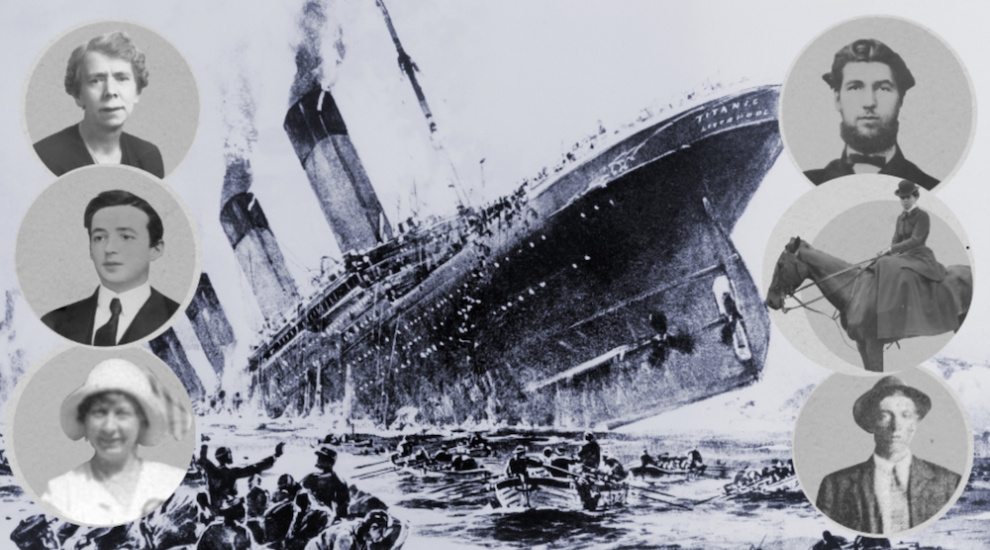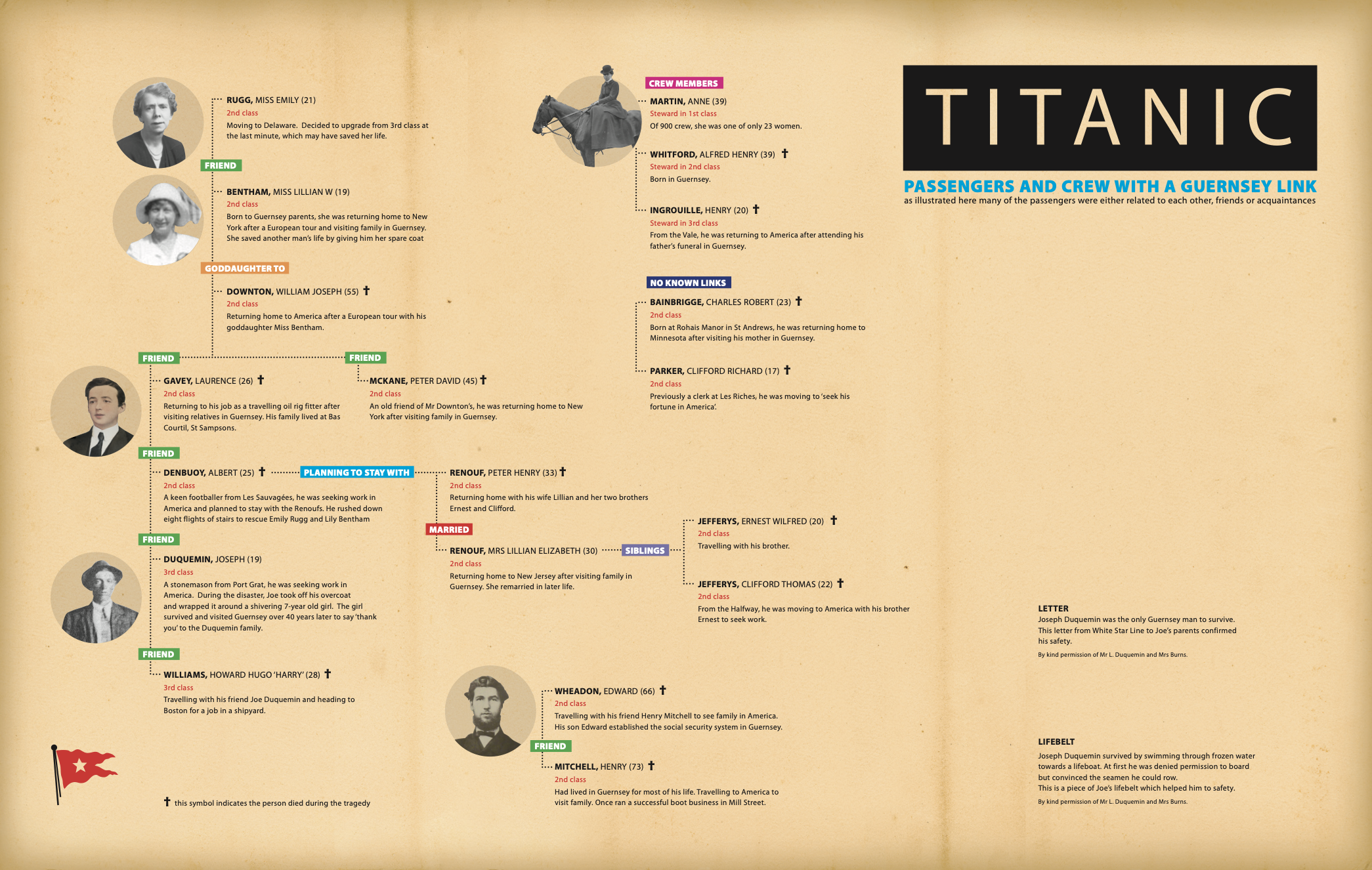


With a Guernsey-based business being responsible for the clearest images yet from the site of the Titanic wreck, we've taken a look back in time at the 19 passengers with a Bailiwick link, only five of whom survived the sinking.
Names such as Ingrouille, Duquemin, and Renouf were among the estimated 2,240 passengers and crew aboard Titanic when she set sail from Southampton.
The passengers were a mixture of First, Second and Third Class - also known as 'Steerage' - while the estimated 900 crew members covered a variety of jobs including chefs, engineers, and stewards.
With more than 1,500 people dying after Titanic hit an iceberg and sank in April 1912, it remains the most infamous shipwreck in history.
Guernsey-based deep and ultra-deepwater site investigation, subsea intervention and seabed mapping specialists, Magellan created a full-sized digital scan of the sunken liner last year.
The joint operation with Atlantic Productions, which is making a documentary about the project, led to astonishing videos and images being captured which look as though the water has been drained away to give a clearer view of the wreck.
Analysis of these images have already shown bottles of champagne and shoes lying on the sea bed, along with a gold and shark tooth necklace.

Pictured: Guernsey based business Magellan has been creating a 3D digital map of the Titanic wreck and surrounding sea-bed.
The personal effects could have belonged to a passenger or a crew member, with Magellan now trying to find out who took the necklace on board. They're using Artificial Intelligence to scan videos and pictures of passengers embarking in Southampton to see what can be matched up with items discovered in the wreckage more than 110 years later.
With tickets to board Titanic for its ill-fated crossing to New York costing from the equivalent of £300 for a Third Class child, almost £2,000 for a Second Class adult, and around £4,000 for an adult in First Class it would be easy to presume any valuable jewellery had belonged to the wealthier passengers aboard.
Of the 19 people aboard with a Guernsey connection, none were travelling in First Class and only one - Miss Anne Martin - was working in First Class,
All the others were travelling or working in Second or Third class accommodation. It may therefore be considered unlikely that any of the passengers or crew with Guernsey connections would have owned the Megalodon necklace, but other items already identified through Magellan's mapping such as shoes could have belonged to anyone on board.

Pictured: A Guernsey Museums graphic depicting the Guernsey residents, and others with a local connection, on board Titanic, and their links to each other.
Guernsey Museums holds material relating to the local passengers and crew on board Titanic - which featured in a display at the former-Maritime Museum at Castle Cornet with further information on its website.
Stating that "Guernsey at that time was an extremely close-knit community", it's reported that "most of the passengers knew each other".
In 1912, Guernsey's economy was described as "not exactly vibrant" with "a lot of emigration and travel to and fro".
Titanic's much fan-fared sailing to the United States of America provided an opportunity for people to seek work there, while other passengers had been visiting family in Guernsey before travelling back to America.
Lillian Bentham survived the sinking. She was 19-years-old at the time of Titanic's maiden voyage and she was travelling in Second Class, returning to New York having been on a trip to Europe which included visiting family in Guernsey. It's reported that she had saved a man's life by giving him her spare coat.
Lillian Renouf was 30 when she boarded Titanic to sail home to New Jersey as a Second Class passenger. She had been visiting family in Guernsey. Her husband and brothers both drowned when Titanic went down. She remarried in later life.
Emily Rugg survived. She was 21-years-old when she boarded Titanic. She had upgraded her ticket from Third Class to Second Class at the last minute and Guernsey Museums said that may have been what saved her life. She was recorded as being rescued by Lifeboat 12. Her initial destination had been Delaware. It's believed she lived in America for the rest of her life.
Anne Martin was a Stewardess working in the First Class section of Titanic. At 39-years-old she was one of only 23 female crew members. She survived.
Joseph Duquemin was the only male passengers from Guernsey to survive the sinking of Titanic. At 19-years-old, the stonemason from Port Grat was seeking work in America. He travelled in Third Class and his known destination was New York. As Titanic was going down, Guernsey Museums said he "took off his overcoat and wrapped it around a shivering 7-year old girl. The girl survived and visited Guernsey over 40 years later to say ‘thank you’ to the Duquemin family". Mr Duquemin did not return to Guernsey and was said to suffer badly with frostbite after the tragedy. His story is told in more detail HERE.
Charles Bainbrigge originally of Rohais Manor, St Andrew's drowned on Titanic aged 23. He had travelled back to Guernsey from his home in Minnesota to visit his mother.
Albert Denbuoy from Les Savaugees was described as "a keen footballer". He was moving from Guernsey to New Jersey, planning to find work. He had intended to stay with the Renoufs - a Guernsey couple who also died aboard Titanic. Travelling in Second Class, Guernsey Museums said "he rushed down eight flights of stairs to rescue Emily Rugg and Lily Bentham" who both survived the sinking.
William Downton died at 55 on his return voyage to America after a European tour with his goddaughter Lillian Bentham.
Lawrence Gavey was 26-years-old when he booked a Second Class ticket to sail back to his job in America as a travelling oil rig fitter after visiting relatives in Guernsey. His family had lived at Bas Courtil, St Sampsons.
Clifford Jeffreys was seeking work in America alongside his brother. At 22-years-old he left his family home at the Halfway and bought a Second Class ticket to America with New Jersey listed as his destination.
Ernest Jeffreys was 20 when he left his home at the Halfway, heading for New Jersey, alongside his elder brother. Both men were travelling with their sister and her husband who had already set up home in America. Both Jeffreys brothers died aboard Titanic.
Henry Mitchell had run a "successful boot business in Mill Street" before booking a Second Class ticket to sail to America to visit family in Ohio. The 73-year-old died when Titanic sank.
Peter McKane had been visiting family in Guernsey before dying on Titanic aged 45. Guernsey Museums said he was "an old friend of Mr Downton's" who also drowned aboard Titanic.
Clifford Parker is described by Guernsey Museums as having been 17 when he boarded Titanic, but Wikipedia lists him as being 28. At 17 he would have been the youngest Guernsey passenger aboard the stricken ship. Travelling Second Class, he was moving to "seek his fortune in America" having previously worked as a clerk at Les Riches.
Peter Renouf was travelling with his wife (who survived) and her two brothers (who both died). The 33-year-old lived in America and was "returning home" with his wife and in-laws as Second Class passengers aboard Titanic. He drowned along with his brothers-in-law.
Edward Wheadon was heading to Rhode Island to visit family. The 66-year-old was a Second Class passenger and was survived by relatives in Guernsey including his son Edward who went on to establish the island's social security system.
Howard Williams was 28 when he booked his ill-fated Third Class ticket to start a new life in Boston, New York, with a job lined up in a shipyard.
Henry Ingrouille was a steward in Third Class. At just 20, he had already left his home in the Vale and was returning to America after attending his father's funeral in Guernsey.
Alfred Whitford was born in Guernsey and was working as a steward in Second Class on Titanic when he died aged 39.
Gold and shark-tooth necklace found on Titanic
Comments
Comments on this story express the views of the commentator only, not Bailiwick Publishing. We are unable to guarantee the accuracy of any of those comments.